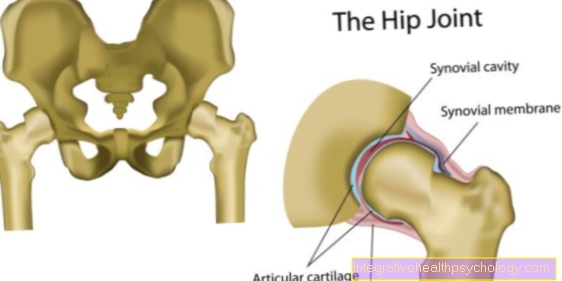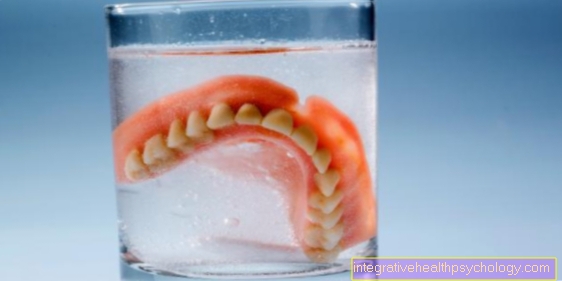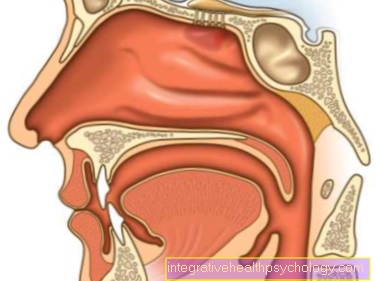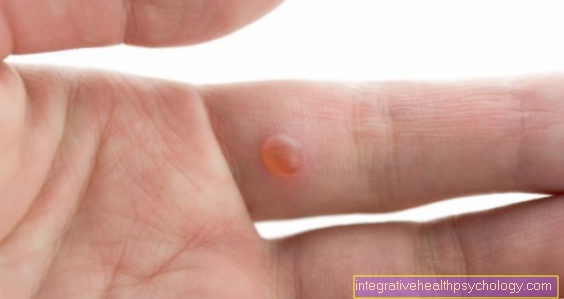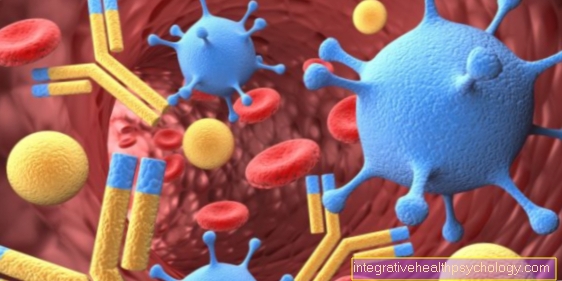Allergy on the face - what's behind it?
Definition - what is an allergy on the face?
An allergy is basically an excessive reaction of the immune system to foreign substances: Various substances are released that cause symptoms such as skin rash, burning sensation and itching.
One speaks of an allergy on the face when such complaints can be observed on the face. Usually the reason for this is direct contact with the allergen, i.e. the substance to which the body is allergic. This includes cosmetics that are used on the face. Food intolerances can also manifest themselves on the face.

Causes of an allergy on the face
The causes and mechanisms of allergies are not yet fully understood, but there are two models that can explain some of the processes.
On the one hand, one is sure that there can be a genetic component in allergies. Children of allergy sufferers are significantly more likely to be allergy sufferers compared to other people. The susceptibility to various allergies is therefore inheritable. Another theory suggests that exposure to foreign substances plays a major role. So if you already have to deal with many potentially allergy-causing substances in childhood, you will get your body used to these substances at an early stage. The immune system does not perceive them as a danger and there are hardly any allergies.
In contrast, those who grow up in a very clean and hygienic environment have little contact with such substances, which is why the immune system contributes reacts more strongly to later contact. The hypothesis is supported by the fact that people living in rural areas are significantly less likely to develop allergies than city dwellers.
The causes of allergies that present on the face are usually contact allergens. For example, cosmetic products that have direct skin contact on the face and lead to the release of the substance histamine. This is significantly involved in alerting the immune system. Food also often causes allergies on the face. By ingesting the food with the mouth, contact takes place in close proximity to the face. The signs are often a rash around the mouth and swollen lips.
Read more on the topic: Rash On The Face - What Is The Cause?
Allergy from cosmetics
Cosmetics usually contain many different substances. These often include highly allergenic components that trigger allergies in many people.
The direct contact with the skin leads to a rapid immune response, which is caused by the release of the substance histamine. This leads to itching, reddening and swelling of the contact points. Small, painful or itchy blisters can also develop. In particular, cheap cosmetics cause allergies. Black make-up utensils are also often the cause of allergic reactions. The black color is a mixture of many ingredients, so that people with a tendency to allergies will find many allergens to which they can react.
Read more about this: Contact allergy
Can stress trigger an allergy?
Stress in itself does not trigger an allergic reaction. So you can't be allergic to increased stress.
Nevertheless, the stress unbalances our immune system and thus promotes the allergic reaction to various substances. In addition, the body's metabolism is unbalanced during stress. This can, for example, lead to a disruption of the skin barrier, which allows allergens to penetrate the skin better. This is particularly important in the case of cosmetic-induced allergies on the face.
pollen allergy
Pollen is usually inhaled through the nose and mouth and therefore causes allergic symptoms, especially in the upper airways.
However, due to the first contact with the pollen in the oral and nasal mucosa, complaints in the facial area are not uncommon, and an itchy rash is particularly common. In addition, pollen often gets into the eyes. The conjunctiva there is poorly protected against the penetration of pollen, which can lead to burning, itching and swelling of the eyes and eyelids.
For more information, see: pollen allergy
These symptoms tell me that I have an allergy on my face
Facial allergies can take different forms and depend in part on the type of allergen they come into contact with.
Allergies that are triggered by ingredients in cosmetics are mostly superficial and only in the areas where the skin came into contact with the cosmetic product in question. The signs of an allergic reaction are usually reddening of the skin, the rash can also itch, sometimes blisters appear, or the skin is particularly dry and flaky.
In the case of a food allergy, the symptoms are usually a little different: as a rule, the mouth and throat area are most affected, and there are skin changes on the face, which are mainly around the mouth. The focus here is on swelling of the oral mucosa and lips. The lips may burn or itch, and a reddish rash may appear. Wheals are less common.
With a pollen allergy, the nose and eyes are mostly affected. Here the pollen irritates the mucous membranes. This leads to a lot of mucus production on the nose, and nosebleeds are also possible. The eyes are particularly sensitive to pollen, as the conjunctiva has only weak protection against the penetration of pollen. As a result, eyes can quickly become red, itchy and burn. Swelling of the eyelids is also not uncommon.
Further information on this topic can be found at: Symptoms of an allergy
Rash on the face
A rash on the face can be caused by a variety of allergies. Mostly it is due to a cosmetic product whose ingredient the person concerned is reacting to. These can be different types of creams and lotions, and make-up utensils often trigger allergies. Rashes that are more pronounced around the mouth are usually caused by food intolerances. The rash on the face can present itself as a simple reddening, pustules or wheals are also possible. The rash is usually itchy and / or burning.
Read more on the topic: Rash On The Face - What Is The Cause?
Swelling of the face
A swelling on the face can be caused by an allergy. The eyes can be particularly prominent if there is an allergic reaction to pollen. Those affected are usually plagued by the symptoms while the pollen they react to is flying. Pronounced swellings on the lips and / or tongue can be an indication of a food intolerance or allergy. Anyone who is stung by an insect in the facial area usually has to struggle with swelling anyway. However, if you are allergic to bees, for example, the swelling can be particularly pronounced. A systemic allergic reaction with swelling of the airways and associated severe shortness of breath is also possible.
For more information, see: Swelling on the face - what's behind it
Quincke's edema
Quincke's edema, also called angioedema, is a swelling of the subcutaneous tissue and subcutaneous fat.
This swelling is particularly noticeable on the face, where it occurs mainly on the forehead, cheeks and lips. The allergic Quincke edema is triggered by the release of histamine. There is also hereditary Quincke edema. The most important distinguishing feature is the additional itching that occurs in the allergic edema. There is also a strong feeling of tension in the skin. Quincke edema on the face is usually triggered by allergies to food or medication.
More on this: Drug intolerance
Pimples - is there an allergy behind it?
Pimples on the face are not necessarily caused by an allergy. Often such pimples are more likely to be found due to small blemishes on the skin.
If someone uses a lot of make-up or creams, this can damage the skin. Applying the products clogs the pores of the skin, which can quickly lead to inflammation. The inflammation then often presents itself as annoying pimples, especially on the face. Those who suffer from allergies, on the other hand, are more likely to have blisters or wheals that develop on the contact surfaces with cosmetic products.
Also read our topic: Impure skin causes and treatment
Treatment of the allergy
Therapy for an allergic reaction on the face consists of various components. The most important of these is the removal of the allergen.
So if you have a food intolerance, you should completely avoid the food in question. Contact allergies can also be avoided by not using the offending cosmetics. For particularly sensitive people, there are cosmetic products that are less allergenic and can be used.
Allergy sufferers suffering from hay fever can usually not completely escape the pollen and must therefore resort to medication during the pollen season. Antihistamines are an important group of drugs for the treatment of allergies. These inhibit the release of histamine in the body and thereby curb the reaction of the immune system. Antihistamines are usually taken as tablets.
Skin rashes due to allergies are usually treated with creams and ointments containing cortisone. These reduce the reaction of the immune system and at the same time have an anti-inflammatory effect. Nasal sprays and eye drops are used against a runny nose and watery or burning eyes. Above all, these should provide sufficient moisture to the irritated mucous membranes, but can also contain anti-allergic agents.
For more information, see: Therapy for an allergy
Duration of the allergy
An allergy on the face can present itself in different forms and mainly has different causes.
The duration of the symptoms changes depending on the cause. Contact allergies cause a rash that usually goes away after a few days. Symptoms of food allergies, on the other hand, are usually shorter. In general, there is no cure for facial allergies, so it lasts for a lifetime. However, the symptoms can be completely avoided if there is no contact with the allergen.
You may also be interested in this topic: Rash from an allergy
Diagnosis of allergy on the face
The diagnosis of an allergy to the face is usually based on the doctor-patient conversation, during which the doctor inquires about specific complaints in the facial area.
In addition, physical signs such as a rash, puffy eyes, and reddening of the face indicate an allergy on the face. A detailed diagnosis also includes determining the triggering allergen. The prick test is used for this, in which various allergens are injected into the skin on the forearm. If someone is allergic to a certain substance, after a few minutes an itchy, reddened swelling appears exactly at the puncture site.
Read more on the topic: Allergy diagnostics


